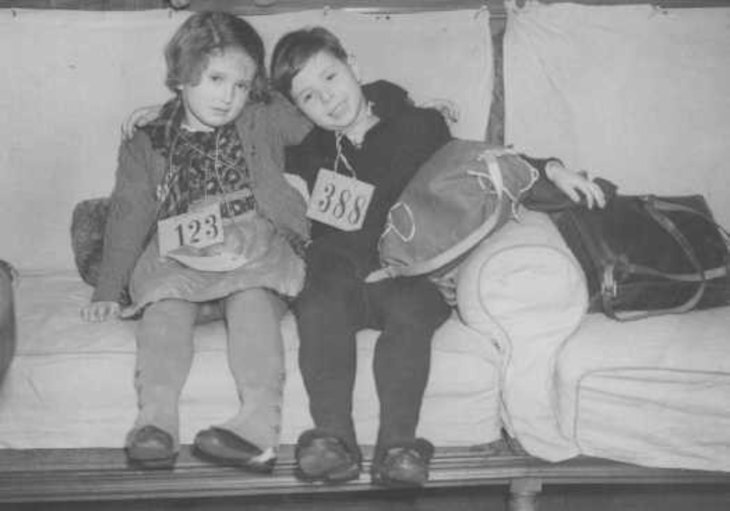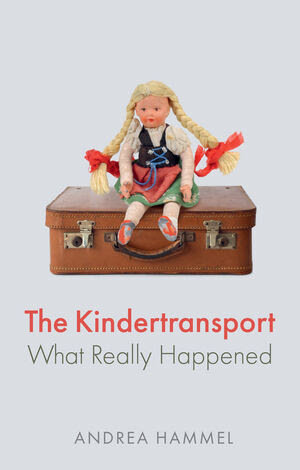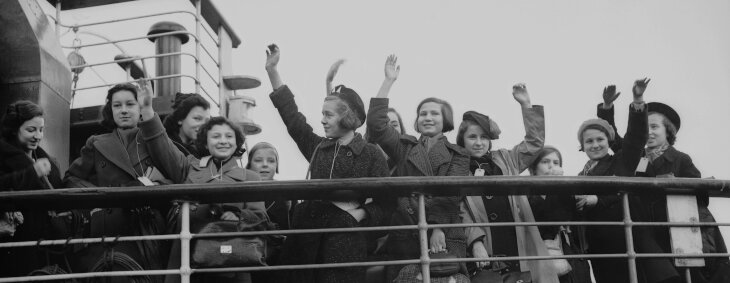 You Know More Hebrew Words Than You Think
You Know More Hebrew Words Than You Think


7 min read
A new book reveals the darker side of the operation that rescued 10,000 children from Nazi Germany.
In the late 1930s, as the Nazis began targeting Jews and sending them to ghettos, work camps, and to their deaths, the British government came up with a plan to save Jewish children. They were going to introduce the Kindertransport, where unaccompanied minors who were under 17 years of age and from the German Reich could gain refugee status and enter Great Britain.
In between 1938 and 1940, around 10,000 children and young people fled from Germany, Austria, Poland, and Czechoslovakia on the Kindertransport to the UK. British child welfare organizations made sure the children would have shelter and education, and Jews, Quakers, and Christians worked together to ensure the safety and protection of these children. The Kindertransport was seen as a success story, and Great Britain was praised for its effort to save thousands of young Jewish refugees.
However, as time went on, stories came out that showed the darker side. And now, in her new book “The Kindertransport: What Really Happened” (Polity, Jan 2024), author Andrea Hammel is setting the record straight on the operation.
For more than 20 years, Hammel, who is professor of German and the director of the Centre for the Movement of People at Aberystwyth University, has been researching refugees who fled from National Socialism to the UK. Much of her work has focused on refugees who ended up in Wales.
 Jewish children arrive in the Harwich, Great Britain, Dec 12, 1938, on a Kindertransport
Jewish children arrive in the Harwich, Great Britain, Dec 12, 1938, on a Kindertransport
One story that stood out to her was that of William Dieneman, an 8-year-old Jewish child who witnessed Kristallnacht, the November 1938 pogrom in Berlin. The Gestapo arrested and assaulted William’s father, and in January 1939, he was put on a Kindertransport with his older sister Ursula, headed to Great Britain. Their parents were not allowed to accompany them.
William and Ursula were separated and shuffled around to various foster families. She ended up with a family who used her as a free babysitter and maid. While William eventually was enrolled in a boarding school – and his parents ended up escaping Germany – they never lived together again. Hammel writes this was “a fate that was not uncommon at all, even if the parents managed to escape to the same country as the children.”
Another child refugee, Ruth David, escaped with her sister Hannah on the Kindertransport. When she arrived, she was placed in two children’s homes, where the adults beat some of the children there. She was separated from Hannah and her other four siblings, as well as her parents, who were eventually murdered by the Nazis.
Hammel sympathizes with the Kindertransport children, writing, “How did the children feel when their families decided that they should part and the children should escape unaccompanied on a Kindertransport?”
In the book, an account from Kindertransport refugee Martha Immerdauer, who was only 9 years old when she escaped Vienna, is shown:
“When my parents broke this news to me, I was devastated and burst into hysterical sobs at the mere thought… I felt as though some force stronger than myself was dragging me into an abyss and I had no power to prevent it… I had seen and understood the build-up of terror in the last two years, so I knew very well that my parents were doing this out of sheer necessity.”
The truth is that a number of children were forever separated from their parents who ended up being killed during the Holocaust. At the very least, parents and children would experience the trauma of separation, which would haunt them for the rest of their lives.
“To admit only the children, and not their parents and families, is clearly one of the most controversial aspects of the Kindertransport,” Hammel writes. “It has sometimes been suggested that parting from your own children was seen as more normal and less painful at that time.”

Additionally, Hammel reveals that the Kindertransport was started as a political move.
“People do not realize that the Kindertransport was essentially a visa waiver scheme initiated by the British government, but that the financial and organizational effort had to be shouldered by volunteers and charities including the Jewish community,” she said. “The UK government even demanded that a guarantee of £50 per child had to be raised to indemnify it against any future expense.”
There was also speculation as to whether or not the politicians at the time realized how traumatizing the Kindertransport would be on child refugees and their families.
“My research of parliamentary debates in November 1938 shows that they were aware of this consequence and went ahead with this controversial policy anyway,” she said.
The book also shows the consequences of the decision to leave the financing and the organization of the Kindertransport mostly to charities and volunteers.

“Financial and other pressures led to a selection of suitable candidates for a Kindertransport that disadvantaged children with disabilities and mental health problems,” Hammel said. “Correspondence between organizers even showed eugenicist and antisemitic views.”
Hammel writes about one applicant, a girl named Kitty Milch, who was described as “an intelligent looking and not particularly Jewish” girl. She was just the type of child who should be given sanctuary in Great Britain, the Kindertransport organizers decided.
“They tried to select ‘high-quality’ children who would be easy to place, make a good impression on the host community, and potentially make a good contribution to the economy and society in due course,” Hammel writes.
If a child was deemed to have “behavioral issues,” they would not be accepted. This was nearly impossible, since these children had witnessed horrors and were living under monumental stress at a pivotal time in their lives.
“Even minor problems such as bed-wetting were seen as a reason to reject an application,” Hammel writes. “If the reports on the applicants suggested any additional needs, the applications had little chance of success.”
While Hammel highlights all the problems with the Kindertransport, she does recognize that the efforts of volunteers and NGOs saved thousands of children. It’s just not a model for dealing with similar refugee crises.
“These people deserve our admiration,” she said. “But my book also shows the limit of their abilities. We need to look into finding stable routes and support for sanctuary seekers to escape persecution and conflict.”
There is little reliable statistical data on the Kindertransport – according to Hammel, it isn’t known how many of the refugees were reunited with their parents and families following the war. Either way, she said, “those reunions were not easy for many, as both children and surviving parents had experienced a lot of trauma and a long separation.”

In writing “The Kindertransport: What Really Happened,” Hammel hopes to shed truth on a controversial past, but also to bring some clarity to the Kindertransport survivors and their descendants. Hopefully, knowing that the truth is out there, survivors’ troubling experiences will finally be validated and understood.
“It is important to have historically accurate information about the persecution of Jewish by the National Socialist regime, and the limited action taken to alleviate the suffering and allow some Jews to find sanctuary outside the German Reich,” she said. “The descendants of these refugees are our fellow citizens in the UK and the US, and their history should be recognized and respected.”
Click here to read related article: How a Kindertransport Saved and Shaped My Mother-in-Law’s Life

womp womp
There is another new book by Amy Williams and bill Niven on national and transnational memories of the kindertransport Camden house New York and the film one life about Nicholas Winton who rescued over 650 children and my sister was one of them.
Why is nothing mentioned on the exploits of Rabbi Solomon Schonfeld who saved thousands of children by bringing them to England from Nazi - occupied Europe with the Kindertransport ? Once they arrived here he placed them into families around the country and opened a Shomer Shabbos School in Shefford with Dr Judith Grunfeld and looked after the Jewish children throughout the entire war. After the war he carried on with his work. He built the Adass Yisroel organisation which today has 100's of Shuls in the UK and founded the Hasmonean School Movement with 1000's of Jewish children getting a religious Jewish education over the last 70+ years What a Malach !
An important book. See also: "The Uprooted", by Dorit Bader Whiteman, herself a child refugee from Nazi-occupied Austria. She interviewed 190 child refugees who were among Kindertransport, and discusses their experiences. Dorit Whiteman became a psychologist in the USA; she passed away in 2022, age 98.
Leading up to the Second World War, Britain had the space and resources in their vast empire for the desperate Jews of Germany and Austria. All of them! If they had been sent to India or British Guyana, for example, would the locals have even noticed? Instead, they "did the Jews a favor", accepting selected children, so they could pose as humane. Between these facts and the White Paper (1939) which prevented Jewish immigration to British Mandatory Palestine, the UK was complicit in the Holocaust. Jewish lives had limited value.
It should be noted that the British also mass-evacuated British city children to stay with strangers in the countryside during WW2 as the cities were seen as more likely to be bombed.
My mother was born in Berlin. In order to save his family of four, he was invited to London and arranged for my mother to be on the Kindertransport in April '39 at the age of 10. She was sent to work in a Jewish home in England for a few months and my grandfather would visit her. In August '39, my grandmother and uncle of 2 yrs.,arrived to England. They were united and spent the war in the town of Kettering, where my grandfather served as Rabbi and head of the Jewish community. After the war my grandfather and teenage daughter were active in absorbing and helping "the Boys". My mother wrote her memoirs in a private publication for our family. Many of us live in Israel. She always felt that she was one of the lucky ones.
In reference to the article- what was the point?
I have read the book. Many of these comments are off-beam. The book is history - not trying to “accomplish” anything, other than investigating the past, which is what historians do. The Kindertransport was a mixed phenomenon, although - of course - it saved lives. (It should also be noted that it is common to say that almost any children who managed to escape, or to be successfully sent out of Germany by their parents, “came on the Kindertransport”, which is often not the case.). As some of the comments note, what happened; the policies of the Government; the policies of the individuals and organizations involved etc etc cannot be judged by the standards afforded by hindsight. There may be some - perhaps a lot - of criticism of the Anglo-Jewish community, who could have done more.
But these were desperate times. In addition - very, very few people imagined the scale and ferocity of the Nazi policies; and many today don't appreciate the anti-Jewish sentiment in Britain at the time, which put the Jewish community under tremendous pressure. Many years ago, Judith Tydor Baumel of Bar Ilan U wrote about the attitude of the UK Jewish community to the refugee children - it was very unflattering.
I agree more with some of the commenters that I do with the author. Would it have been better if these children died? How can he expect anybody who is doing the selfless, generous act of taking in these poor children, expected to deal with two adults, when there was already food, shortages and housing, shortages in England, And to deal with severe behavior problems that nobody is equipped to know how to handle. That would have seriously cut back the number of children that were saved. I think they did a great job taking all those children out and placing them in homes. Was it ideal? No, but it was much better than the.
i don't think the author of the book meant it would be better that the children would not have been saved. it's recognizing the trauma that happened to them and that this story, although yes saved children, is not the rosy picture that is usually presented. The horror continued. This book is giving a more nuanced, fuller view of what actually took place. That is what good history does
My mother left Germany on Kindertransport at age 15. My uncle at age 13. Yes, they experienced the trauma of Kristallnacht during which My grandfather was arrested. He spent a month in Dachau during which my grandmother had a nervous breakdown. The Kindertransport saved the life of my mother and uncle. My grandparents were murdered. Yes, the separation was traumatic. But it saved their lives. Should Britain have taken in the parents too? Obviously. And so should have the US who didn't even accept the children. But I think it's rather poor scholarship to critique Britain for not dealing better with the trauma of the refugees. It was 1938-39. Not 2024. You cannot judge the past by the standards of the present
My Father came over with, I think, his deaf, mute and blind elder brother and their
Mother; however, his Father, my Grandfather, perished or was murdered in Treblinka.
I'm not sure what Ms. Hammel is looking to accomplish with this work. My grandmother and her brother were rescued from Germany on a Kinderstransport. It was certainly traumatic for both of them, as well as their mother, who was already left alone by that time as her husband had been captured by the Gestapo, never to be heard from or seen again. But they survived and eventually married and raised families.
It's no secret that many of the children brought to England at that time ended up in less than ideal circumstances. But what would their circumstances have looked like had they been forced to stay with their families?
The actions by the government of the UK at that time were nothing less than heroic. And unfortunately, far, far greater than any other country in the world.
War is a crime, a crime against children and families. Options have limits. Even in times of peace, foster care is not a loving family. Individuals, organizations, or governments can't save or give everybody what they need and deserve. Broken children grow up to be productive adults at an amazing rate of success.
My mother and uncle at 11 and 8 were out in the transport asking with 5(?) Cousins in Dec 1938 from Berlin. Just after kristalnacht which my mother witnessed in their apt. She went to Amsterdam for 1.5 years in a childrens home. My uncle went to a family. My grandparents brought him back at some point and made their way out in 1939 and then to the us. My mother was out on a ship in may 1940 to Manchester and a childrens home and then America in 1944. There is more, but it family did escape intact. I have met other g2 from kinder over the years...
My mum came from Vienna on the kindertransport in 1939. She was adopted by a Jewish couple in Liverpool who had no children of their own. To me they were always my grandparents. My brother & I were not told what had actually happened until many years later. When we eventually found out it was a huge shock. My mother had lost her accent & we had no inkling that she had come from Austria. She hardly talked about her past but the trauma of it stayed with her all her life. She never saw any of her family again. The most profound remark she made was when she told me she could still see her mother’s face in front of her ( over 70 years later) & remembered how pale she was as she said goodbye on the platform.
Better watch ‘One Life’ the true story of Nicholas Winton who managed the mammoth task of personally being responsible for saving over 600 young lives; all of whom were meticulously documented and lived to eventually meet the man. Those 600+ saved are now 6000 and counting.
My darling mother-in-law was one of the Kindertransport children and her mother and father made it to Great Britain too. She was so grateful to our nation until the day she died. I don't think it's fair to judge 1940's well meaning actions by 2024 standards.
The problems mentioned were on a par for that time. The Great Depression(1929) had happened not long beforehand. It was common then for children to be sent to live with better-off relatives, distant cousins, etc. I would have preferred an article dealing with how many of the children remained Jewish and what kind of lives they later had. That should have been the most important consideration.
Excellent! Thanks for your insights. Steven Finer